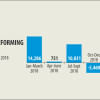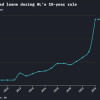Janata Bank comes short of BB’s targets

Janata Bank has failed to meet any of its performance improvement targets set by the central bank in the first half of the year -- a worrying development given that the state bank accounts for the second-highest volume of deposits and loans among the 61 scheduled lenders in Bangladesh.
Since 2007, the Bangladesh Bank has been setting biannual performance improvement targets such as cash recovery from defaulters, bringing down defaulted loan ratio, improving capital base, credit growth, profitability and so on for the four state-owned commercial banks to restore their financial health.
In the first six months of the year, Janata Bank underperformed in all metrics, according to the compliance report prepared by the central bank's department of off-site supervision.
For instance, BB has a set individual ceiling for all four banks' large loan portfolios based on their defaulted loan ratios -- and Janata overshot the limit by a wide margin.
As of June 30, large loans accounted for 64 percent of Janata's total portfolio. Its ceiling for the period was 30 percent.
"It is not possible to bring down the large loan concentration at will," said Md. Abdul Jabbar, the managing director and chief executive officer of Janata Bank.
The bank has taken on a five-year plan to reduce its large loan exposure.
"We are not giving new loans to large borrowers, so the volume won't increase in the coming months," said Jabbar, who took charge in April this year.
For Sonali, the ceiling was 38 percent and its large loan portfolio was 48 percent of all loans.
Agrani's large loan portfolio accounted for 34 percent of its total outstanding credit as of June 30 whereas the ceiling was 30 percent.
Agrani Bank has not approved any large loans in the last two years, according to its chairman Zaid Bakht.
"Our large loan concentration is not increasing in recent times, and we are no longer lending to these large borrowers by exceeding the exposure limit," said Md Murshedul Kabir, the MD and CEO of Agrani Bank.
Agrani is strictly monitoring the loans that have already exceeded the exposure limit, he added.
Bakht said Agrani is reducing its large loan concentration as per the instruction of the central bank.
Rupali's large loan portfolio was within the BB-imposed ceiling of 34 percent.
As of June 30, Janata had the highest number of large loan borrowers (67) and the highest proportion of large borrowers that have exceeded the single borrower exposure limit of 25 percent of capital.
Sonali had 21 large borrowers and 13 exceeded the single-borrower exposure limit, according to the BB report published on November 14.
Most of Sonali Bank's large borrowers are state-run companies and agencies, said its MD and CEO Md. Afzal Karim. "And their repayment behaviour is good," he added.
Of Sonali's 21 large borrowers, 17 are public sector borrowers, according to the BB report.
Agrani had 55 large borrowers and 20 of their exposure was over the limit. As of June 30, Rupali had 35 large borrowers and the exposure of 10 of them was above the ceiling set for a single borrower.
Janata had the highest number of its large borrowers defaulting on their loans: 17.
The other three banks together had 17 large borrowers defaulting on their loans at the end of June.
Janata's 17 large borrowers defaulted on Tk 10,841 crore, which is more than the total of three banks' large borrowers' soured loans.
The report did not name the large borrowers whose exposure limit was above the permissible limit or those who had defaulted on their loans.
Another performance improvement target was bringing down the credit concentration in the banks' top five branches.
Both Sonali and Agrani managed to bring down the credit concentration in their top five branches by 2 percentage points. Rupali's credit concentration in its top five branches stayed the same as six months earlier.
Janata's credit concentration in its top five branches, however, increased between December 31 last year and June 30 this year, according to the BB report.
As much as 77 percent of its total outstanding credit amounting to Tk 93,371 crore was disbursed from its top five branches: Local Office branch, Janata Bhaban Corporate branch, Sadharan Bima Bhaban Corporate branch in Chattogram, Dilkusha Corporate branch and Motijheel Corporate branch.
The remaining 23 percent of the credit was extended through 917 branches across the country, including its four overseas branches.
The central bank also set individual targets for cash recovery from the top 20 defaulters and the other defaulters and from written-off loans and Janata fared the worst in two of the three categories.
"Cash recovery is very difficult amid the ongoing economic situation," said the Janata MD Jabbar, adding that his bank recovered a good portion of loans through rescheduling.
In the first six months of the year, Janata's cash recovery from its top 20 defaulters was Tk 16 crore, which is just 2 percent of the target. Agrani also managed to recover just 2 percent of its target from its top 20 defaulters.
Sonali retrieved Tk 26 crore, which is 9 percent of its cash recovery target from its top 20 defaulters in the first half of the year.
Rupali recovered Tk 65 crore from its top 20 defaulters, which is 19 percent of its target. It also fared the best when it came to cash recovery from its other defaulters: it retrieved Tk 268 crore, which is 47 percent of the target.
"We will see a good result by the year-end because a good portion of the loans are in the process of becoming regular through rescheduling," said Mohammad Jahangir, the MD and CEO of Rupali Bank.
The bank is making good loan recovery from its large borrowers, which will also help bring down its large loan concentration, he added.
Janata managed to meet 17 percent of its cash recovery target from its other defaulters, which is the lowest among the four.
The bank, however, fared comparatively better when it came to cash recovery from written-off loans: it recovered Tk 28 crore, which is 8 percent of the target. Sonali also managed just 8 percent of its cash recovery target from written-off loans.
The central bank has called for a reduction in their classified loans and here too, Janata fared the worst.
Let alone bring down the volume, Janata's classified loans went up by 87.8 percent in the first six months of the year, according to the BB report.
At the end of June, as much as 32.6 percent of its total outstanding loans were classified, which is the highest among the four and substantially more than the other three banks.
Both Rupali and Sonali managed to bring down their classified loans by 12.86 percent and 1.37 percent respectively in the first six months of 2023, while Agrani's classified loans increased by 7.11 percent.
As per the agreement with the BB, at least 50 percent of Janata, Agrani and Rupali's new adjusted loans must be disbursed to CMSMEs, retail and other small borrowers. For Sonali, it is 40 percent.
While Sonali met its target comfortably, the other three banks failed.
"We are now trying to balance our loan portfolio by focusing more on SME and agriculture loans," said the Agrani MD Kabir.
Save for Rupali, the other three banks' capital position deteriorated in the first six months of the year, according to the report.
The banks' capital to risk-weighted assets ratio (CRAR) was supposed to be at least 10 percent, and Sonali's CRAR barely meets the floor set by the BB. The other three banks' CRAR falls short.

 For all latest news, follow The Daily Star's Google News channel.
For all latest news, follow The Daily Star's Google News channel. 








Comments